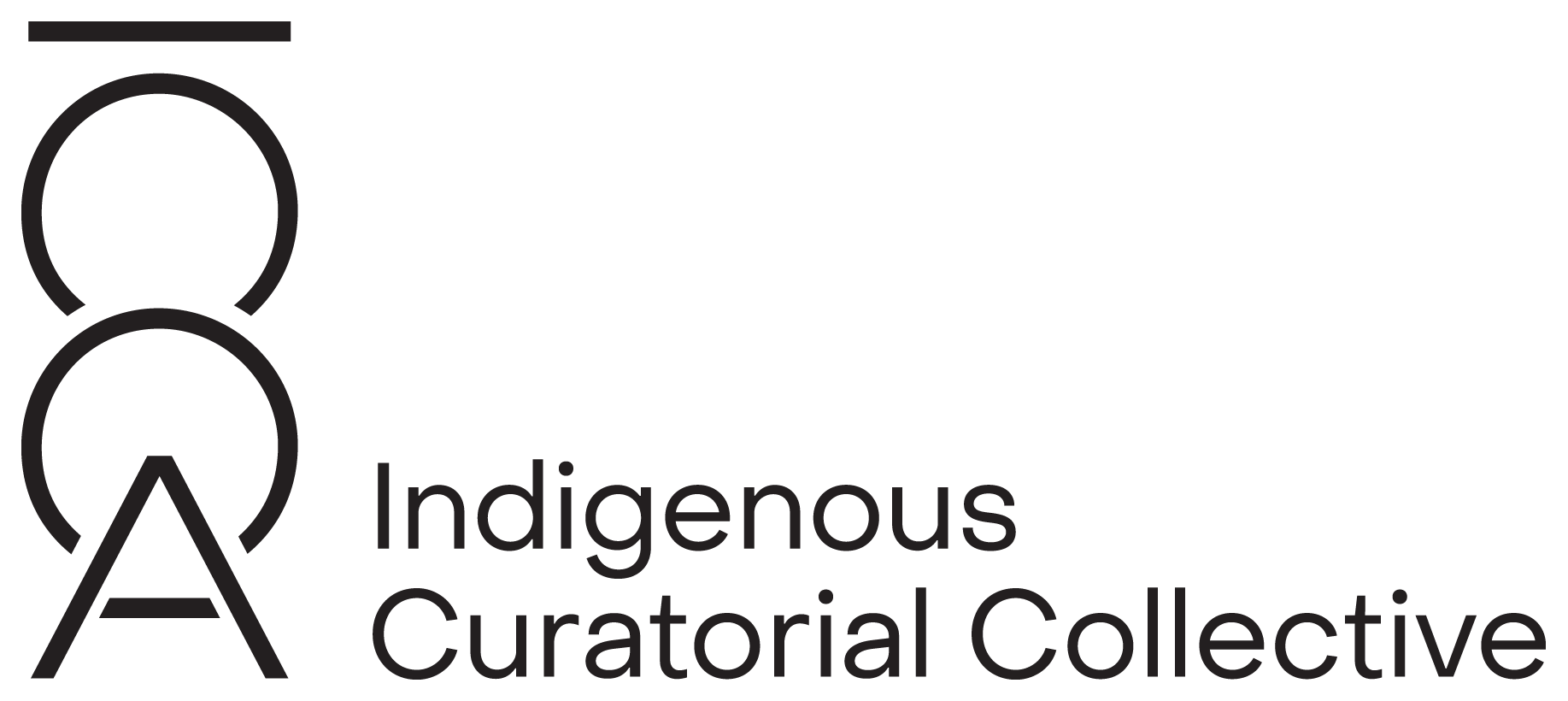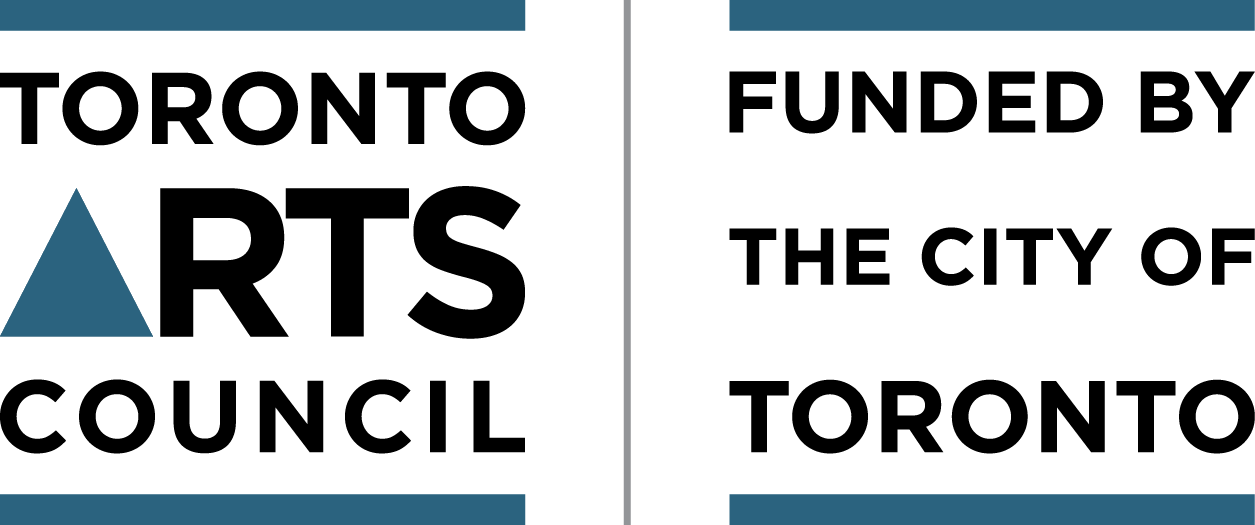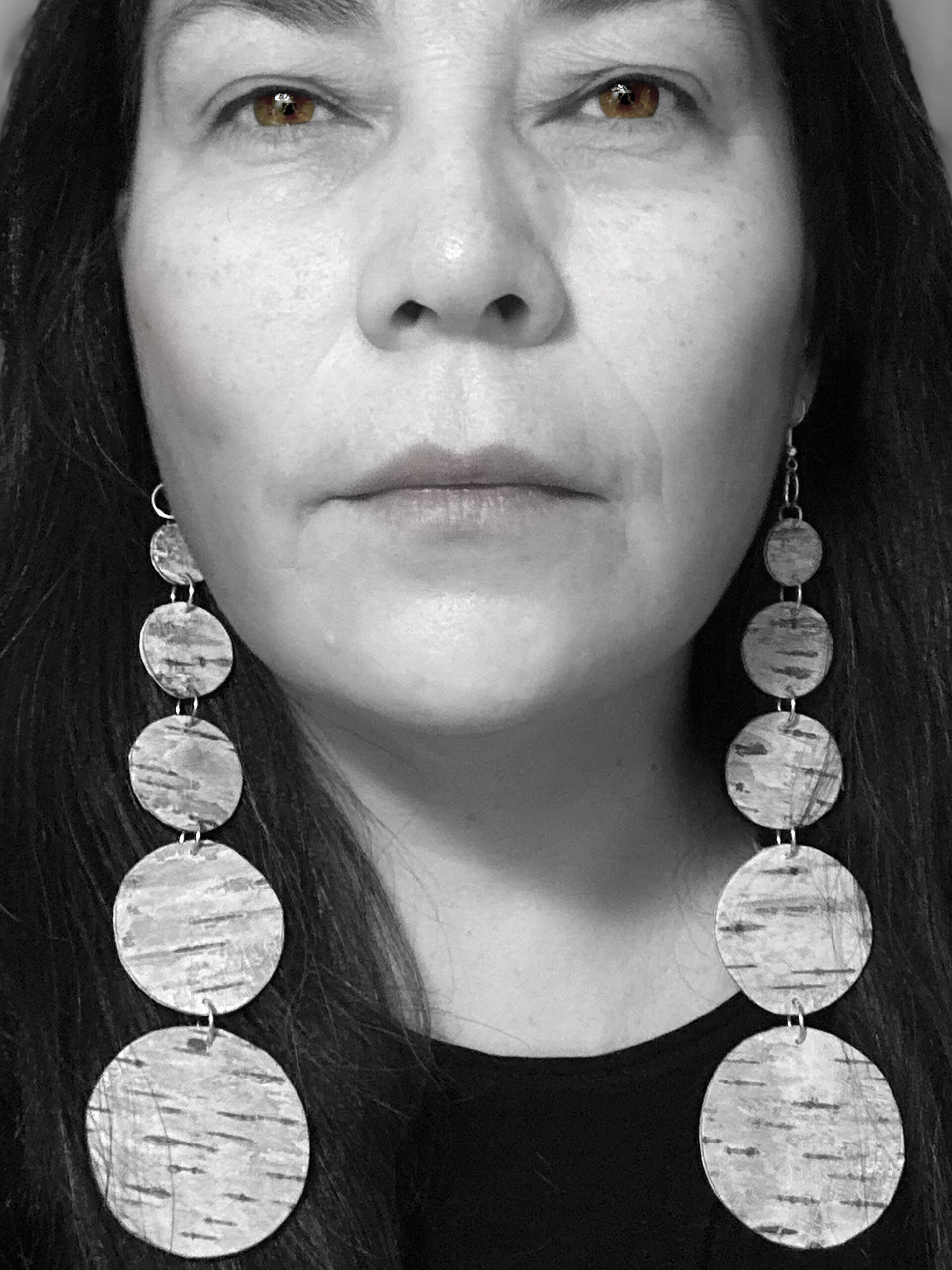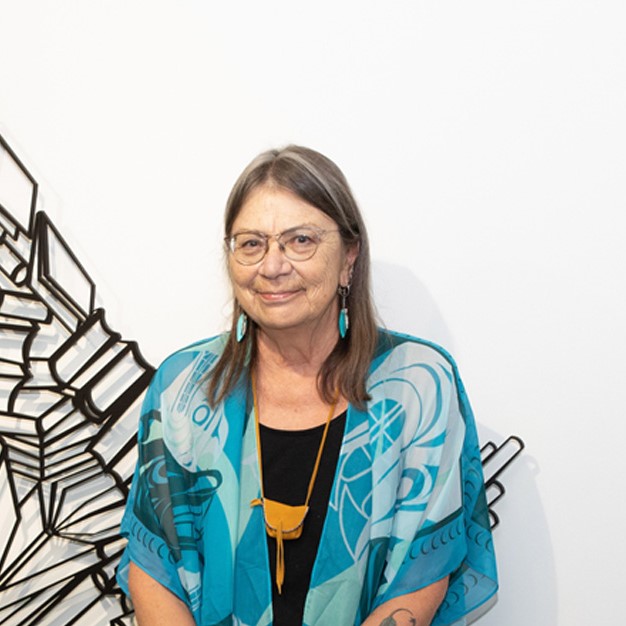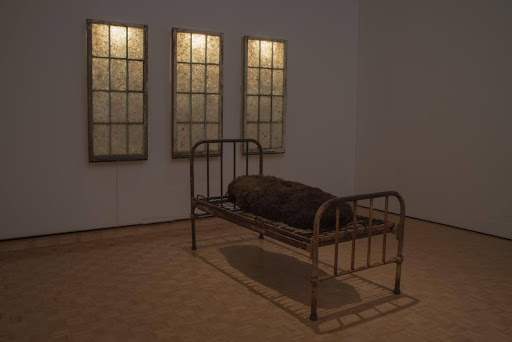
Adrian Stimson, Sick and Tired (2004). Image: Mackenzie Art Gallery.
Remembering Moving Forward, Never Forgetting
by David Garneau
A small room in a large gallery houses a rusty bed frame, three decrepit windows, and ghosts. As a young man, Adrian Stimson salvaged these relics from the Old Sun Indian Residential School during its renovation and repurposing. He wasn’t sure why they needed saving; he just knew they did. It was only decades later, after he became an artist, that he found new life for these haunted objects—as a memorial. The Siksika artist altered the artifacts to create Sick and Tired (2004). He backlit the windows and stuffed them with feathers to evoke insulation and isolation: “I can imagine children peering out of these windows, longing to be home with their families. Yet their reality was confinement, similar to being smothered by a pillow” (Stimson 2011). Adrian’s father was one of those kids. Placed in the middle of the bedsprings of the rusty bed frame is a buffalo robe that seems to cocoon a child’s body. The bundle memorializes the thousands of young people who died in these places and the countless more whose languages, cultures, innocence, and spirits were stolen there. It conflates the children with the decimated bison, both central to Blackfoot society. Disturbed by the installation, some First Nation folks refused to enter, telling the Story Keepers and me that they recognized the cast iron bed from their residential school days. It raised bad memories. The bundle and bed frame reminded others of how Blackfoot traditionally released their dead.[1] The gallery became a place of remembering and mourning, a sacred space whose energies were not entirely contained.[2]
Michelle LaVallee and I[3] curated Moving Forward, Never Forgetting for the MacKenzie Art Gallery in Regina, Saskatchewan (February 28 – April 19, 2015). The exhibition and its many events concerned Native[4] folks reconciling with their families and difficult histories, and conciliation[5] between Natives and non-Natives. I use ‘creative conciliation’ to refer to artistic and cultural efforts to represent, perform or nurture good relations between Indigenous and non-Indigenous people. Central to our project was the desire to practice curation as care; not only for objects but people. Once we completed the art selection and installation, our attention shifted to the living and the present moment. Although significant funding came from an academic grant (Social Sciences and Humanities Research Council), we did not want to turn the artists and folks engaging the art and programming into research subjects. We wanted to focus on listening over recording, oral storytelling over writing, relationships rather than reporting. We hoped our visitors would feel like guests rather than subjects. Some photographs were taken, but there are no audio or video recordings of the opening, the four performances, numerous workshops, talks, symposium, or other events. We didn’t solicit testimonials, take surveys, or write essays. Because we centered visiting over data, tea over explication, our participants, I believe, felt well hosted, however, Moving Forward, Never Forgetting remains little known beyond this circle. Six years later, upon an invitation from my Creative Conciliations colleagues, we reconsidered our position. What follows is not a catalogue essay but an evocation of some artworks, words from the artists to offer a feel of the exhibition, and a recollection of curatorial experiences and innovations shared in the hope of being useful for others. While Michelle and I originally planned a dialogue of texts, we were unable to do so due to conflicting schedules.[6] What follows is a monologue, a partial and personal remembrance.
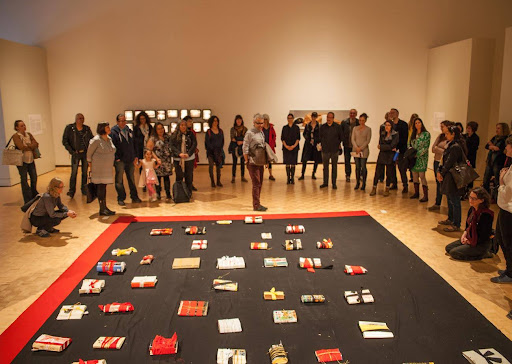
Peter Morin, de-colonize my heart, 2015. Performance documentation courtesy the Mackenzie Art Gallery.
Seven people sit on the floor and wash books. The volumes, selected for their anti-Native content, were donated to Tahltan artist Peter Morin for his performance de-colonize my heart. Some are children’s picture books and romance novels with stereotyped characters. Others are misinformed history and anthropology tomes. “These texts,” Peter explains, “tell an untrue story of our Indigenous presence, knowledge, culture and contributions. These books are a repository of the colonial manifest destiny and were in need of cleansing, healing, and de-colonizing” (Morin 2015). The five adults and two children, all in white shirts, sing and drum as they bathe each page in a medicinal tea. The sodden volumes are carried into the large gallery and laid on a large red-trimmed black blanket to dry. When the exhibition closes, Peter buries the books across Northern Turtle Island. Asked why he takes such care with the offensive publications, why he doesn’t just destroy them, he explains that the books are former trees and deserve to return to the soil. While the narratives are distorted and harmful, they are the result of labour, and human work deserves honouring (Morin 2015).
Through textiles, photographs, installations, paintings, sculptures, video, performances, workshops, a symposium, and other conversations, Moving Forward, Never Forgetting encouraged deeper understandings of contemporary Native experience. The exhibition gathered beautiful, haunting, homey, occasionally humorous, and always moving works of connection, reconnection, and resilience. It engaged the intergenerational and intercultural effects of the aggressive assimilation of First Nations and Métis people.[7] The artists wrestled with the cumulative effects of Indian Residential Schools, day schools, public schools, land and language loss, and other deprivations and abuses. They explored how government policies and ingrained anti-Native racism distorts lives, families, and relationships, including those with their settler neighbours. At the same time, they offered glimpses of hope: examples of cross-cultural friendship, family rebuilding, cultural and spiritual continuance and transcendence. The artists included: Michael Belmore, Rebecca Belmore, David Benjoe, Leah Decter, Audrey Dreaver, Faye HeavyShield, Julianne Beaudin-Herney, Terrance Houle, Jaimie Isaac, Cheryl L’Hirondelle, Amy Malbeuf, Dylan Miner, Peter Morin, Jane Ash Poitras, Skeena Reece, Sandra Semchuk and James Nicholas, and Adrian Stimson.
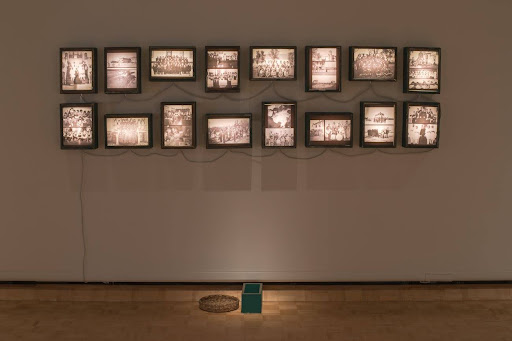
Jaimie Isaac, Illuminatus/Inabe. Image: Mackenzie Art Gallery.
Illuminatus/Inabe (2015) is a collection of old photographs set in sixteen light boxes and arranged on the wall in a grid. The twenty-eight images document life at the Fort Alexander Indian Residential School at Sagkeeng First Nation in Manitoba. Jaimie Isaac (Anishinaabe), copied the images from originals in Library and Archives Canada and the Shingwauk Residential School Centre. Most show nuns and priests surrounded by orderly young bodies in white and black clothing. These are official documents proving that the school was doing its job, “civilizing” Natives. Other pictures are more casual: snapshots of a student band, children writing or drawing and on outings. Are they, too, staged? Knowing what we now know about these places, can we trust any of their representations? Isaac asks,
What is beyond the frame? The boxes are like windows and we are voyeurs looking into the past and trying to see beyond these careful representations. But what are we looking for: the truth, a spectacle? What is our business to know? One tragedy is that no one—not the attendees and their families, not the supervisors, teachers, and other workers—will know all that lies behind these poignant pictures. But, they do offer intriguing glimpses (Isaac 2015).
The artist’s mother, grandparents, and other family members attended this school.
In 2011, as part of his PhD research into art, healing, and Truth and Reconciliation (TRC), Jonathan Dewar paid me a visit in Regina. He asked if I had considered curating or making art about the subject. I said “no.” I was critical of the official TRC’s premises and processes and couldn’t imagine contributing. No one in my immediate family went to an Indian Residential School. There had been a large one in St. Paul des Métis, where my great-great-grandparents and their descendants lived. In 1903, just a year after construction, the school burned to the ground. Fifteen Métis children were arrested for arson. They said they set the fire to end their poor treatment. Hearing the details, the judge released them (Olshefsky 2013). In 1978, I worked at a summer camp at Lac Ste. Anne run by Franciscan nuns and, in 1980, at their main residence, the Atonement Home, in Edmonton. The “Home” was an emergency shelter for children, mostly First Nations and Métis. Some stayed a week, several for more than a year. I made a video, Black Pepper (1999), about an experience there but it wasn’t until my interview with Jonathan that I considered the Home’s resonance with Indian Residential Schools: the nuns were quartered on the top floor, next down was the girl’s, then the boy’s dorms, an office and visiting floor, then the basement kitchen, dining, and play area. The dorms had infirmary beds, identical to the one in Stimson’s Sick and Tired, arranged in grids.
Spurred by Jonathan’s visit, by conversations with primary and intergenerational survivors (including artists Adrian Stimson, Robert Houle, and Alex Janvier), and witnessing three of the national TRC events, my sense of how this difficult subject might be respectfully and creatively engaged expanded. In 2012, I wrote an unsuccessful SSHRC application to research and curate an exhibition, Unsettled, which would feature artist responses to the Australian and Canadian government apologies to “their” Aboriginal peoples. That fall, Ashok Mathur invited me to give a paper at a gathering at the former Shingwauk Indian Residential School at Sault Ste. Marie, where Jonathan was working. Ashok explained that Keavy Martin (principle researcher), Dylan Robinson, Jonathan, and he were assembling a related art-after-the TRC proposal. I was already working with Keavy and Dylan on a TRC project.[8] They offered to include me in their application for the next round. That application, titled Beyond Reconciliation, was successful. We received funding for five years of work. My primary contribution would be curatorial. In 2013, I pitched a version of Unsettling, but without Australian artists, to Timothy Long, Head Curator at the MacKenzie Art Gallery. He agreed and suggested I partner with Michelle LaVallee. Michelle and I may have considered this project before I spoke with Long. In any case, our collaboration carried our conversation much further. Michelle and I first met at an Aboriginal Curatorial Collective[9] gathering in Saskatoon in 2006. She was living in Toronto but soon relocated to Regina to work at the MacKenzie. Our friendship deepened in 2010, when we spent two weeks with eight other First Nations and Métis curators on a trip to New Zealand and Australia.[10]

Terrance Houle, Untitled (kokum/dad), 2009. Image: Mackenzie Art Gallery.
When Terrance Houle’s paternal grandmother died (2001), she left her son a large box of letters, every one he had written her, weekly from Residential School and monthly from wherever in the world the military posted him. In 2009, for the installation Untitled (kokum/dad), Terrance recreated his kookum’s sitting area. Houle said, “She had a rocking chair or recliner couch, a radio set upon an end table with doilies, religious paraphernalia, photos, an old carpet and some really bad cheap paint she bought from the ‘as is’ bin. I remember her listening to talk radio, rez radio, bingo or religious songs” (Houle 2015). The Blood artist made a two-hour recording of his dad reading his letters in English and Saulteaux/Ojibway. Lean in to hear his voice coming from the radio.
The work is powerful and one of the hardest I have ever created. In making it I realized how distant my grandmother and father’s lives were, that the policies put in place to create a rift within Aboriginal families, especially mother/child, had worked. They had an alienating relationship that was distant, held only by story, letters, and phone calls. (Houle 2015).
Prior to colonization, people indigenous to Turtle Island did not divide art from life. They lived in, with and wore their creative objects. Art—in the sense of aesthetic things made by people but separated from everyday life, isolated from the non-visual senses, and stored in special rooms for optical contemplation—is a European and modern convention. Such divisions, honeycombed into complex hierarchies, structure the colonial, patriarchal, white supremacist capitalist system we endure. While a return to pre-contact days is impossible, struggle toward non-colonial futures is an ethical necessity. First Nations, Inuit and Métis peoples participate in both the dominant society and our traditional cultures. We are bi-cultural. As a modest means toward a just and holistic end, we require institutions that educate our children and keep our art to also be bi-cultural (and multi-cultural) and non-colonial. When a nation (Canada) seeks to benefit by controlling and exploiting the minds, bodies, cultural objects, resources, and territories of other nations (First Nations, the Inuit, and the Métis Nation), we are right to call it colonial. Art galleries and museums are colonial, for example, when they separate Native belongings from Native bodies and care. Indigenous curation is a form of stewardship, not just of objects but also people. Art galleries and museums can be (at least momentarily) non-colonial when we build and nurture good relations between people and art works.
Art galleries and museums may seem magnanimous when they “make space” for Indigenous art, but they remain assimilationist when they host Native curators but disable Indigenous curation. That is, First Nations, Inuit and Métis curators are colonial subjects when they are required to perform as if they were non-Native. Such institutions are non-colonial only when they enable Native curators to learn, develop and practice Indigenous curatorial methodologies. Morin’s performance asks us to be fully human, to have compassion even when dealing with difficult content. Rather than burn the offending books, he washes them like bodies prepared for burial. I was moved by his loving gesture. Sovereign Indigenous display territories (Garneau 2012) are exhibitions of Native creativity stewarded by Native people following Indigenous methodologies on territory temporarily or permanently theirs. The MacKenzie Art Gallery has a long history of showing First Nations, Inuit and Métis art, and of hosting fulltime First Nations curators, including Michelle LaVallee, Pat Deadman, Lee-Anne Martin and Felicia Gay, and Métis guest curators such as Bob Boyer and me.[11] Michelle and I felt we could deepen these good relations. Our goal was not only to contribute to the re/conciliation project preoccupying Canadians, but also to further Indigenize[12] our practices and those of our colleagues, and to enrich the MacKenzie’s relations with local First Nations and Métis communities.
It is not exclusively an Indigenous thing, but Beat Nation (2008), Transits and Returns (2019), the National Gallery of Canada’s Sakahàn (2013) and Àbadakone (2019) exhibitions, as well as projects by the ReMatriate, Ociciwan, and other collectives demonstrate that collaborations are the preferred practice among Indigenous curators. It is about both sharing the load and dispersing power. Instead of being the expression of a single preference, collaborations foreground relationships, and the negotiation and performance of shared principles. Gender-balance is not just about equity, it is about marshaling complimentary experiences for richer results.[13] Michelle and I divided our tasks to suit our preferences, skills, and proximity to resources. She has more institutional curatorial experience. All my projects have been independent or as a guest curator. Michelle has a high emotional intelligence, prioritizes people and relationships, and has strong managerial skills. We are grounded by similar Indigenous experiences and shared ethics, are excited by Indigenous contemporary art and artists, and like to make things happen.
Michelle’s work at the MacKenzie was extraordinary—she curated the essential 7: The Professional Native Indian Artists Incorporation (2013), among many other important projects, and collected key works for the MacKenzie (including several in this exhibition). While she had the support of the Gallery, her deep work could have been eased. I’m not referring to the usual curatorial labours of this often, difficult job, but the extra care Indigenous curators are required to carry. Explaining to non-Native folks why Elders need to be consulted, and which Elders; when spiritual elements need to be engaged—and when not, because it might become a spectacle, is exhausting. Explaining what the community value of a work might be; how the inclusion of an artwork or person might be read in traditional communities or the Indigenous art world; the special pressure of being Indigenous but not indigenous to this region; the importance of developing relations over time, and not just to fulfill a timely task, is difficult. Lacking Indigenous colleagues, she carried a great deal of weight alone. Working together, we were able to initiate ideas and processes that neither of us could have done on our own. To be clear, I was not an employee at the Gallery. Michelle carried the day-to-day work, with support from the administration and installation staff.[14]
In addition to the initial exhibition concepts and Creative Conciliations funding, I brought my unpaid labour. I have mixed feelings about this choice. We had a limited budget and I could only see the things we would jettison if I were paid. I had a professor’s salary and felt I could invest this privilege. In retrospect, a great deal of Indigenous cultural work goes unpaid or underpaid. Of particular concern is the fact that when professors or other such professionals do pro bono work it displaces freelance curators, and may depress the perceived value of this labour.
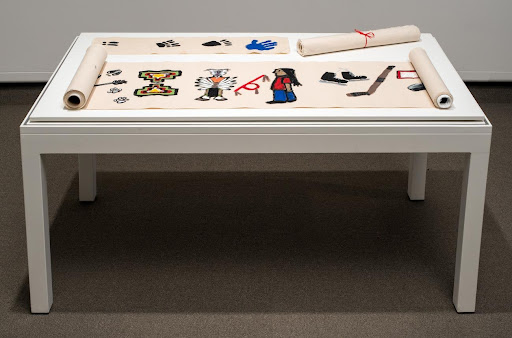
David Benjoe, Acimowin Anaskanak – Story Scrolls, 2015. Image: MacKenzie Art Gallery.
A canvas scroll lies under a display case. Only one of its eight meters is visible at a time. The artist, David Benjoe (Cree/Lakota) returns every few days to lift the glass and unspool a new section. The scroll’s paintings are rough and cryptic: a pair of thick-framed glasses, a car crash, a man and a horse, animal tracks, Cree syllabics, and other symbols. As part of his Masters’ research (Art History/Education), David considered the therapeutic value of tipi liner painting. Traditionally, men from Great Plains societies who returned from battle with what is now called post-traumatic stress disorder were encouraged to paint their experiences on hides or canvas (Rosoff 2010). These tipi liners were hung in their homes. Warriors lived, literally and figuratively, with their deeds. The coded images were only legible when their maker animated them with talk. The speaker/maker could share as little or as much of their story as they needed.[15] David made his own version, a story scroll rather than a tipi liner, as a means of coping with PTSD. He went to the Lebret Indian Residential School, as did his father and many other relatives. He showed his scroll to his dad, and explained its cathartic effects, how making it and talking about the images allowed him to picture and discuss experiences and feelings he couldn’t otherwise expose. The elder Benjoe said he would like to paint one, too, but that he “would need a lot of black” (Benjoe 2017). David’s son also made a small scroll. It lay in the plexiglass case beside his Dad’s. David’s father came to the opening and saw the scrolls. He asked why his wasn’t included. A few days later, the generations were symbolically united; David’s scroll, his son’s scroll, and David Benjoe senior’s scroll were displayed together.[16]
Witnesses: Art and Canada’s Indian Residential Schools (September 6–December 1, 2013) at the Morris and Helen Belkin Art Gallery was a multi-curator[17] exhibition that coincided with the National TRC event held in Vancouver in 2013. That brilliant and gut-wrenching show influenced our efforts to develop Moving Forward. For example, we borrowed Skeena Reece’s Touch Me (2013), which was commissioned for Witnesses.
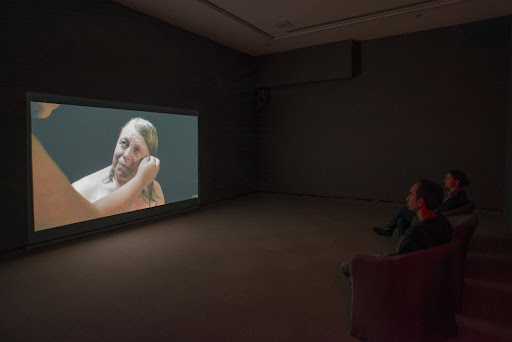
Skeena Reece, Touch Me (2013). Image: MacKenzie Art Gallery.
Coincidentally, I saw the video installation in that exhibition and had it on my wish list, and Michelle had already acquired it for the MacKenzie collection. Because Witnesses focused on the schools and the trauma they inflicted, we felt freed to start there but to emphasize strategies of healing. This was the advice of our Elders Harold Lavallee and Norma Jean Bird. They were concerned about re-traumatizing folks, or having non-Indigenous people see only the dark side of Indigenous experience. They suggested we create a space of making and sharing, not only for Indigenous people, but also for non-Natives, particularly new Canadians with similar experiences (language and cultural loss and recovery, for example). I felt a disconnection between visitors and the Witnesses’ works. Some non-Native people appeared to approach the objects only as art. Checking my perceptions, I asked a young couple, art students, about what they thought of the exhibition. They talked eloquently about formal elements but seemed unable to engage the emotional and content complexity of, for example, a video of an Indigenous woman with her mouth taped shut (Rebecca Belmore’s Apparition, 2003). Other Witnesses visitors said they were disturbed by the content. They wished there had been someone to talk with. A community leader I talked with in Vancouver later suggested that many Native folks wouldn’t go to Witnesses because it is a non-Native space and they heard there was no support.[18] In fact, there was a cardboard display and pamphlets with information about supports, and support workers from the Indian Residential School Survivors Society were on site, though not all the time. All this made me reconsider what it means to host Indigenous people and things in a non-Indigenous space. We made some small steps toward Indigenizing the space, temporarily. To counterbalance the effects of colonization, sovereign Indigenous display territories need more resources than do mainstream spaces and audiences.
Central to the development of the Moving Forward, Never Forgetting concepts, then, was the need for Indigenous care for the duration of the exhibition. Indian Residential School survivors and their relatives would need support. Folks who didn’t know much about the schools and larger contemporary issues would need more than the art and texts could provide. Story Keepers were Indigenous folks with personal experience and training who could help people relate with the potentially triggering content. They were there to listen and share, provide support but also instigate conversations. They actively hosted the guests. Michelle and I fleshed out the concept and Caitlin Mullen wrote the grants[19] that made these positions, as well as extra training for the regular gallery facilitators, possible. We hired artists rather than crisis counselors. We were fortunate to attract wonderful people: powwow dancer Lacy Morin-Desjarlais (Saulteaux), rapper Brad Bellegarde/InfoRed (Nakota/Cree), filmmaker Janine Windolph (Woodland Cree), and textile artist Melanie Monique Rose (Métis).[20]
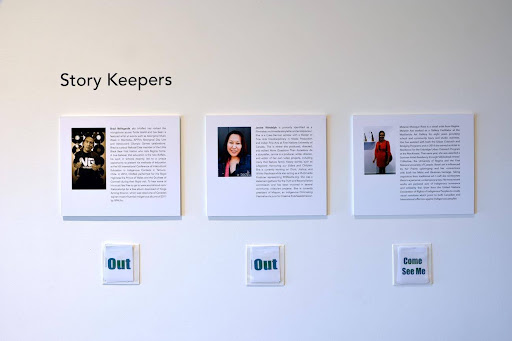
Image: Mackenzie Art Gallery.
The Story Keepers were hired several months before the exhibition opened. We introduced them to the curatorial concepts and the artworks. We had them research and, where possible, contact the artists. This redistributed curatorial authority somewhat. There is a considerable distance between curators and visitors in conventional exhibitions. While curators give talks and tours, artworks are often left to “speak for themselves,” with assistance from gallery facilitators who often repeat curatorial talking points. Story Keepers did their own research and often had knowledge we lacked. Because gallery facilitators were crucial to our concept of curation as care, we provided them with twelve hours of extra training. The Curator of Public Programs and Community Engagement, Nicolle Nugent, was deeply involved from the beginning. She even participated in Peter Morin’s performance. Nicolle co-facilitated the four three-hour training sessions. The Story Keepers and more than twenty gallery facilitators heard from Elder Norma Jean Byrd about Indigenous ways of knowing and being. Harold Lavalley shared the history of the region and his Indian Residential School experience. Professor Shauneen Pete gave a riveting lecture about anti-racist pedagogy and the role of education in conciliation. Michelle and I described the exhibition, the artists, the artworks, the curatorial concepts, and what we expected of the facilitators. We also held curatorial tours. Facilitators read essays and watched We Were Children (2012). I cannot speak for them, but Nicolle Nugent, the Story Keepers, and facilitators were enthusiastic and appeared to love their work.

Terrance Houle, Friend or Foe #1 and #2, 2010-15. Image: the MacKenzie Art Gallery.
In his Friend or Foe #1 and #2 videos (2010-15), Terrance Houle appears in a breach cloth, breast plate, roach, and sunglasses in various locations: a city street (Calgary, Alberta), a beach (Nelson, British Columbia), and in the midst of a family enjoying a swimming pool (Montenegro, Columbia). Using Plains sign language he signs: “Hello, friend, I am Blackfoot. I am a Buffalo herder. I saw several battles here, Palefaces and Indians. I saw several Indians shot by Paleface riders. I am sad. Goodbye, friends and foes.” What at first may seem an incongruous sight soon reminds us that this is all Native land. A later version, #6, features residents of Dawson City, Yukon, signing about living in the North. One explains that, because of the cold, it is a good place to hide out during a zombie apocalypse. The spirit of the Treaties is about sharing the land equitably, about living together well. Houle seems to suggest that learning a common, non-colonial language, and not one specific to any one First Nation, a language of the land, would be a good step in that direction.
The summer prior to the opening of Moving Forward, I was in Dawson City[21] with Terrance Houle and Dylan Miner. Dylan (Métis) is a printmaker and environmental activist who harvests medicine plants, some of which end up in his prints and installations. His Dawson exhibition, Michif—Michin, at the ODD Gallery, featured prints of plant and handmade baskets to hold the actual medicines. I was most excited, though, by the methodology of visiting in his social relations piece, The Elders Say We Don’t Visit Anymore (2014). Dylan invited locals to have tea and talk. Eight of us sat around a picnic table covered by a Hudson’s Bay blanket. My initial skepticism was overcome by the intensity of the engagement. People felt very welcome and spoke animatedly about their lives in that remote part of the world. I invited Dylan to bring the project to the MacKenzie.
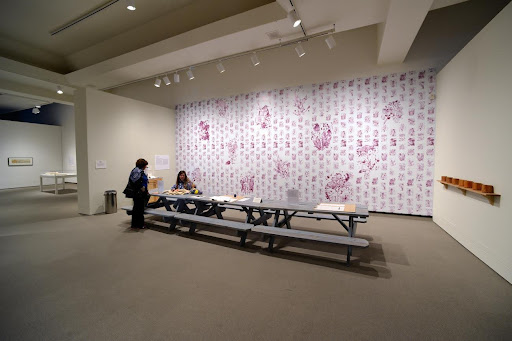
Dylan Miner, The Elders Say We Don’t Visit Anymore, 2014. Image: the MacKenzie Art Gallery.
At the top of the stairs, in what was normally a gallery, he papered the walls with a medicine plant print. Seven birch bark containers filled with medicines were set on a shelf on another wall. In the center of the room were three picnic tables used for visiting, drawing, beading workshops, and other community events.[22] We were surprised and pleased when conservator Brenda Smith allowed us to serve tea and cookies in the gallery. It was a welcoming space, the Story Keepers’ hub.
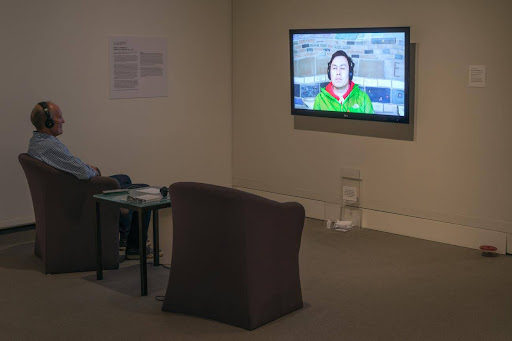
Cheryl L’Hirondelle’s, It Takes a Village… Image: the MacKenzie Art Gallery.
Most exhibitions consist of works coming into the gallery before the opening, staying put, and leaving at the end. Not so with Moving Forward, Never Forgetting. Peter Morin’s installation was made during the opening. Cheryl L’Hirondelle’s (Cree Métis) It Takes a Village…., a music video produced over five days during a collaborative singing/songwriting workshop with youth offenders from the Paul Dojak Youth Detention Facility, arrived part way through the exhibition run. The photo-documentation of Adrian Stimson’s performance was installed several weeks after the opening. Jaimie Isaac and Leah Decter’s (official denial) trade value in progress (2010–2016) twice left the gallery to go visiting.
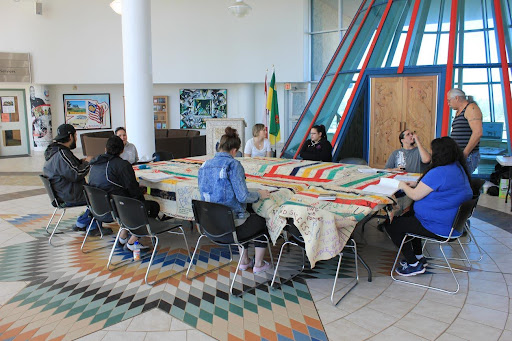
Leah Decter and Jaimie Issac, trade value in progress, 2009-ongoing. Sewing action at the First Nations University of Canada. Image: MacKenzie Art Gallery.
In answer to a question asked of him at the G20 Summit of 2009, then Prime Minister Stephen Harper said of Canada: “We also have no history of colonialism.” Outraged, Leah Decter, a non-Indigenous artist engaged in anti-colonial work, began work on a 12 x 15-foot textile project. (official denial) trade value in progress consists of an assemblage of nine Hudson’s Bay blankets in the middle of which Decter machine-stitched Harper’s infamous claim. She invited people from across the country to write their responses to Harper in a book. Then, she asked others to choose one written response from the book and to stitch that text into the blankets. In 2010, she collaborated with Jaimie Issac to bring these sewing actions to forty places across the country and into the USA. During the run of Moving Forward, Never Forgetting, they took (official denial) from the main gallery to the tables in Dylan Miner’s adjacent visiting space so more stitches could be added. The work also visited the First Nations University campus and to a local First Nation for further sewing actions.
Michael Belmore’s (Anishinaabe) Smoulder (2010) consists of several dozen stones carved and fitted together. The surfaces between, where they almost touch each other, are inlaid with copper. The warm glow has the effect of a dying campfire. Faye HeavyShield’s (Kainai-Blood) floating paper spirits, Aapaskaiyaawa (They are Dancing) (2002), is an arc of twelve long, triangular, hood-shaped figures made of paper and suspended from the ceiling. These fragile forms are at once celebratory, possibly mourning; real presences and markers of absence. Both works are formally beautiful, and are evocative rather than illustrative. Michelle worked with the artists to write extended labels for most works. We saw this as a way to make the art more accessible to audiences less familiar with contemporary art. Many provided context and curatorial interpretations. Most were stories told by the artist.
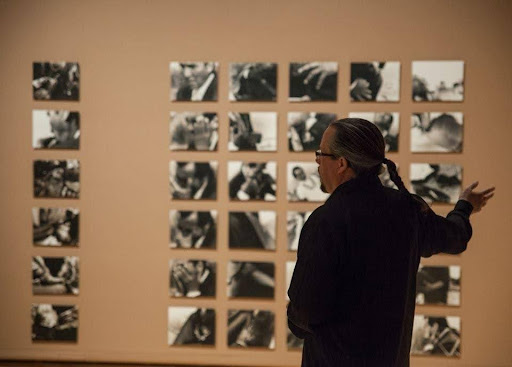
Sandra Semchuk and James Nicholas, Taking Off Skins, 1994. [Temporary image.]
In Taking Off Skins (1994), Sandra Semchuk documents an impromptu performance by her life partner James Nicholas (Rock Cree). A grid of 36 photographs shows a bear being skinned and a ceremony, but this is hard to discern from the pictures alone. In the text accompanying the images, Sandra explains that in the spring of 1994, she and James were at the Friendship Centre in Prince Rupert when that institution’s administrator received a call about a bear that had been killed on the road: “Did the Elders want to skin it for the hide?”[23] James and a friend offered to do the deed and Sandra photographed the operation. James harvested the claws and later made himself a necklace. “He said the bear salved his urban savage soul.” Soon after, the couple went to Kitsilano Beach near downtown Vancouver to conduct and record a ceremony/performance. James, dressed in a suit and tie; “like an Indian who did liaison work between his Band Council and the federal government, a role that he had played for years.” As part of the ceremony/performance, James removed these clothes and “put on the bear claw necklace and the red blanket that I handed him. He walked into the ocean, cleansing himself.”[24] [25]
It is tempting to read Sandra as ethnographer, taking the pictures and writing the explanatory text, and James as the Indigenous subject. But, as she explains in the exhibition text, and in conversation, they were co-creators. He asked her to go to the beach, to record him, and they worked many hours together to edit the pictures and assemble the display. James was a full agent. The artists’ professional care, the negotiated agency of the players assures that they know what they are doing, that their sharing and my viewing is ethical. Sandra is not taking images of James under stealth or false pretenses. She is making photographs with him.
Astute viewers connected Semchuk’s appearance in Taking off Skins (1994) at the beginning of the exhibition and her participation in Skeena Reece’s video at the end. These displays of cross-cultural care bookend the exhibition and offer a sense of hope, a sense of conciliation as caring relationships among individuals. Reece’s video Touch Me (2013) features the artist silently washing the body of an older white woman,[26] Sandra, who is in a large metal tub. Skeena explains:
Defiantly, my work resists the loss of our true history of contact, but it also nods to the accountability that we must have in order to go forward in this society. My response to this painful history is to share the continued ability to show reverence, respect, care and love. Not despite our colonial history, but as a continuation of this strength that has been passed on since time immemorial. Speaking to my people I am saying that these abilities are not lost on me. Speaking to others I am saying this is ‘our’ resilience (Reece 2019).

At the close of the exhibition (March 28, 2015) we held a gathering. Coordinated by Audrey Dreaver, the Indigenous Aesthetic Sovereignty and Creative Conciliations Symposium had public morning sessions, which included Māori curator Megan Tamati-Quennell’s keynote on the state of Indigenous curation and art in Aotearoa/New Zealand, and a performance by Julianne Beaudin Herney. The private afternoon session was to begin with a talking circle followed by themed break-out sessions. However, the circle had more than forty guests. In addition to the Moving Forward, Never Forgetting team, and some of the artists, there was also the Creative Conciliations group, and Indigenous and allied artists and curators from the region and across the country. More than three hours later, we hadn’t fully made it around the circle. For some, it was their first time in such a supportive and knowledgeable group. They needed to hear and be heard. Others had ideas they wanted feedback on. While the format had to change to suit the new needs, the visit was invigorating.
To identify as Indigenous, rather than, say, as a Cree artist or Abénaki curator is to say that your practice exceeds or differs from the culture of your home Nation. To foreground your Indigenous identity over the nation that appears on your passport is to claim that while you participate in that nation’s culture you have a belonging beyond it. Indigenous is an inter-national identity. Indigenous is the set of contemporary relations and modes of being Native. As we curators mature, as we find ways of connecting art and curatorial practices to pre-colonial ways of knowing and being, distinct Indigenous curation methodologies emerge. Moving Forward, Never Forgetting was an effort in that direction.
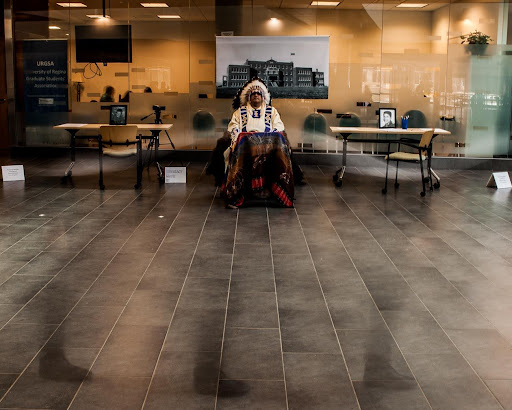
Adrian Stimson, Sounds of Silence, 2015. Durational performance at the University of Regina. Image: Makenzie Art Gallery.
Adrian Stimson sits in a chair in a busy hallway at the University of Regina. Behind him is a large photo of the Indian Residential School, Old Sun, his father attended. He wears his recently passed father’s regalia. From time to time during the three-day performance, passers-by pause to sit in the chair across from the Siksika artist. He is silent. It is as if talking, explaining, would profane the complexity of these experiences. Many are moved by his eloquent quiet, by his generous presence. When a Native man sings and drums for him, Adrian does not break his silence, but emotion washes over his face in waves.
Notes
[1] Many Plains people used to set their dead-on scaffolds in trees away from scavenging wolves.
[2] Adrian Stimson, from his unpublished 2011 artist statement: “I believe that objects hold energy. The windows, feathers, light, shadow, bed, and bison robe are objects and ideas that speak to history, culture, genocide, absence, presence, and fragmentation. Together they form a space to contemplate our present being, and examine ourselves, our relationship to the past, present and future. Creating this installation has been a way for me to exercise and transcend the colonial project, a way to forgiveness, healing and obtaining a state of grace.”
[3] Michelle LaVallee is Ojibway, Chippewas of Nawash Unceded First Nation, Neyaashiinigmiing/Cape Croker, Ontario. She was a curator at the Mackenzie Art Gallery at the time of the exhibition (where she worked from 2007-2017). In 2017 she assumed the role of Director of the Indigenous Art Centre at Crown-Indigenous Relations and Northern Affairs Canada, Gatineau. David Garneau is Métis, a descendant of Laurent and Eleanor Garneau of Edmonton and Red River, and professor of Visual Arts at the University of Regina.
[4] Following the UN Declaration on the Rights of Indigenous Peoples (UNDRIP, 2007), the word ‘Indigenous’ has been accepted by most government and non-government agencies, and many, but not all “Indigenous” Peoples as the hypernym covering all people’s native to a territory. An umbrella term such as this is needed as a short hand to refer to the huge class of diverse Peoples. However, it can also have a distorting effect and is so not acceptable to some of those it tries to describe—for example, Native Australians who prefer Aboriginal or Black. Indigenous people tend to prefer to identify first with their community and clan/tribe, territory/Nation and language. As a result, this text is specific about naming the Nation who claims the artist. And, because ‘Indigenous’ covers all First Peoples around the world, I use that term when that is what I mean, and use ‘First Nations’, ‘Inuit’ and ‘Métis’ when referring to Indigenous people of Northern Turtle Island. Elsewhere, I argue that ‘Indigenous’ also refers to a new class of people, folks who identify with not only their home community, but with Indigenous people elsewhere. They tend to have degrees, live in cities and speak in English, and circulate more within the Indigenous discourse—Indigenous social media, the Indigenous art world, texts and conferences, and among non-Native allies—than they do their home communities. In addition, with increasing talk and action about Indigenizing the academy and other institutions, there is a sense that the Indigenous increasingly refers to that aspect of Native cultures that can be apprehended by non-Indigenous persons and institutions. As a result, in this document I try to use ‘Indigenous’ when referring to this Indigenous class and discourse and Native when I mean to emphasize folks not fully entangled in that class and discourse.
[5] My first written consideration of the Canadian government’s use of Reconciliation and my preference for ‘conciliation’ in “Imaginary Spaces of Conciliation and Reconciliation.” West Coast Line. #74. Jonathan Dewar and Ayumi Goto, eds. Simon Fraser University, Vancouver, 2012. 28-38.
[6] While Michelle was unable to contribute a text, she has reviewed this document for accuracy.
[7] Inuit artists were not included in this exhibition because we decided to focus primarily on regional history and audience. It was designed for this territory and we had no plans to travel it. In hindsight, if we had the capacity to work with Inuit artists and communities, I would particularly have liked to engage Inuit experience in Plains hospitals.
[8] This project allowed me to attend many Truth and Reconciliation events and, later, to expand my Shingwauk talk into a chapter in their book: “Imaginary Spaces of Conciliation and Reconciliation: Art, Curation, and Healing” in Dylan Robinson and Keavy Martin, eds., Arts of Engagement: Taking Aesthetic Action in and Beyond the Truth and Reconciliation Commission of Canada (Waterloo: Wilfred Laurier University Press, Waterloo, 2016): 21-41.
[9] The Aboriginal Curatorial Collective was recently renamed the Indigenous Curatorial Collective.
[10] I moved to Regina from Calgary in 1999 to take a teaching position at the University of Regina.
[11] They have continued this commitment by appointing John G. Hampton (Chickasaw), initially as Director of Programs, followed by his appointment as Executive Director and CEO in 2021.
[11] They have continued this commitment by appointing John G. Hampton (Chickasaw), initially as Director of Programs, followed by his appointment as Executive Director and CEO in 2021.
[12] “Indigenization is the act of making something more native; transformation of some service, idea, etc. to suit a local culture, especially through the use of more indigenous people in administration, employment, etc. The term is primarily used by anthropologists to describe what happens when locals take something from the outside and make it their own (e.g. Africanization, Americanization).” https://en.wikipedia.org/wiki/Indigenization Accessed Jan. 2, 2020.
[13] All the curatorial projects I have engaged since have been partnerships with Indigenous women: with Kathleen Ash Milby, Transformer: Native Art in Light and Sound, National Museum of the American Indian, New York; with Tess Allan, With Secrecy and Despatch, Campbelltown Art Centre, Sydney, Australia; and with Faye Mullen, the Montreal Biennial of Native Art, 2020.
[14] We are particularly grateful to/thankful for Hilary Knutson, who covered for Michelle during her maternity leave, Caitlin Mullen, who wrote grants that enabled us to increase training for the gallery facilitators, and Nicolle Nugent (Curator of Education) and her team, who put in a great deal of extra effort to improve community engagement.
[15] A resonant addition to this room was a ledger drawing by an unknown Cheyenne artist (circa 1860/70). It shows a train taking the artist and other warriors to their incarceration at Fort Marion sometime in the 1860s to 1870s. Many Indigenous visitors to that gallery, which had an education theme, mistook the image for children being taken to Residential School. In the same room as Benjoe’s work, among others, are Audrey Dreaver’s paintings about language loss, No, I don’t speak Cree.
[16] Along with Shauneen Pete, I was David Benjoe’s co-supervisor. I worked with him for five years. Two and a half years after this exhibition, and just a few months from completing his Master’s degree, he died suddenly.
[17] Witnesses was curated by Geoffrey Carr, Dana Claxton, Tarah Hogue, Shelly Rosenblum, Charlotte Townsend-Gault, Keith Wallace and Scott Watson.
[18] Curator Tarah Hogue shared with me that support workers from the Indian Residential School Survivors Society were on-site to offer counseling during the opening reception and intermittently throughout the exhibition run. Other materials, including a cardboard display and informational pamphlets, were also available. Hogue acknowledged the IRSSS contributions as significant but limited by both available resources as well as the prioritization of said resources.
[19] My “strategies of disengagement” echoes Sam McKegney’s critique of non-Indigenous scholars’ tactics of shedding responsibility for doing the hard work of reading Indigenous literatures in his 2007 book Magic Weapons (pp. 39-41).
[20] Donald defines colonialism as “the ongoing process of denying relationship,” in multiple senses.
[21] We were guests of The Natural & the Manufactured thematic residency jointly organized by the ODD Gallery and the Klondike Institute of Art & Culture. Terrance and Dylan were there as artists; I was there to write about their art works.
[22] Among the Moving Forward, Never Forgetting events were David Benjoe’s “Story Scroll” making workshop for Indigenous men and Audrey Drever’s “Mother Tongues” workshops, where participants made art about language loss. We supported the Visual Arts Indigenous Summer Art Residency at the University of Regina. The Vertigo Series presented a songwriting workshop, which resulted in an open-mic event featuring Cheryl L’Hirondelle (Cree Métis) and Moe Clark (Métis). There were numerous school group tours, tours for International Women’s Day, and talks and tours for the Canadian Art Gallery Educators Conference.
[23] This text is from the wall panel. https://themedicineproject.com/sandra-semchuk-james-nicholas.html
[24] “James died October 15, 2007, when he fell 30 meters at a fishing camp on the Fraser River. He would be honoured that this installation is being shown as medicine while residential school settlements are being made and much pain is coming to the surface” (Semchuk 2008).
[25] This paragraph and the next are from David Garneau, “James Nicholas and Sandra Semchuk’s Intimate, Poetic Politics,” an essay in a soon to be published exhibition catalogue, Mackenzie Art Gallery.
[26] Skeena is Métis/Cree and Tsimshian/Gitksan. Sandra Semchuck is Ukrainian Canadian.
BIBLIOGRAPHY
David Benjoe, “Acimowin Anaskanak – Story Scrolls: An Exploration of First Nations Art Practices as a Healing Tool” (Unpublished MA thesis: University of Regina, 2017).
David Garneau, “Imaginary Spaces of Conciliation and Reconciliation,” Jonathan Dewar and Ayumi Goto, eds. (West Coast Line. #74. Simon Fraser University: Vancouver, 2012), 28-38. http://reworksinprogress.ca/?portfolio=wcl-74-reconcile-this
Terrance Houle (unpublished artist statement and exhibition card, 2015).
Jaimie Isaac (unpublished artist statement and exhibition card, 2015).
Peter Morin (unpublished artist statement and exhibition card, 2015).
Alexandrai Olshefsky, “Revisionist History: St. Paul des Métis” (McGill University blogs, June 24, 2013). https://blogs.mcgill.ca/humanrightsinterns/2013/06/24/revistionist-history-st-paul-des-metis/ Accessed Dec. 30, 2019.
Nancy Rosoff and Susan Kennedy Zeller, eds. Tipi: Heritage of the Great Plains (University of Washington Press, 2010). In particular, note Vietnam vet, Harvey Pratt’s (Cheyenne/Arapaho), contemporary tipi liner. P. 98-105.
Skeena Reece cited in “Skeena Reece: Touch me” (GalleriesWest online magazine, April 6, 2018). https://www.gallerieswest.ca/events/skeena-reece-touch-me/), accessed Dec. 22, 2019.
Adrian Stimson (unpublished artist statement written in 2011. Reproduced for the exhibition card, 2015).
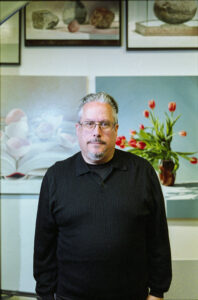 David Garneau (Métis Nation of Saskatchewan) is a Professor of Visual Arts at the University of Regina. He is a painter, curator, and critical art writer who engages in creative expressions of Indigenous contemporary ways of being. Garneau curated Kahwatsiretátie: The Contemporary Native Art Biennial (Montreal, 2020) with assistance from Faye Mullen and Rudi Aker; He co-curated, with Kathleen Ash Milby, Transformer: Native Art in Light and Sound, National Museum of the American Indian, New York (2017). With Tess Allas, he co-curated With Secrecy and Despatch, for the Campbelltown Art Centre, Sydney, Australia (2016). He and Michelle Lavallee curated Moving Forward, Never Forgetting at the Mackenzie Art Gallery (2015). Garneau has given keynotes on mis/appropriation; re/conciliation; public art; museum displays; and Indigenous contemporary art. He presented, Dear John, a performance featuring the spirit of Louis Riel meeting with John A. Macdonald statues in Regina, Kingston, and Ottawa. David recently installed a large public artwork, the Tawatina Bridge paintings, in Edmonton. His recent still life paintings, Dark Chapters, curated by Arin Fay, will tour Canada in 2025. In 2023, Garneau was awarded the Governor General’s Award in Visual and Media Art: Outstanding Achievement and was inducted into the Royal Society of Canada.
David Garneau (Métis Nation of Saskatchewan) is a Professor of Visual Arts at the University of Regina. He is a painter, curator, and critical art writer who engages in creative expressions of Indigenous contemporary ways of being. Garneau curated Kahwatsiretátie: The Contemporary Native Art Biennial (Montreal, 2020) with assistance from Faye Mullen and Rudi Aker; He co-curated, with Kathleen Ash Milby, Transformer: Native Art in Light and Sound, National Museum of the American Indian, New York (2017). With Tess Allas, he co-curated With Secrecy and Despatch, for the Campbelltown Art Centre, Sydney, Australia (2016). He and Michelle Lavallee curated Moving Forward, Never Forgetting at the Mackenzie Art Gallery (2015). Garneau has given keynotes on mis/appropriation; re/conciliation; public art; museum displays; and Indigenous contemporary art. He presented, Dear John, a performance featuring the spirit of Louis Riel meeting with John A. Macdonald statues in Regina, Kingston, and Ottawa. David recently installed a large public artwork, the Tawatina Bridge paintings, in Edmonton. His recent still life paintings, Dark Chapters, curated by Arin Fay, will tour Canada in 2025. In 2023, Garneau was awarded the Governor General’s Award in Visual and Media Art: Outstanding Achievement and was inducted into the Royal Society of Canada.
Photo credit: Mika Abbott
